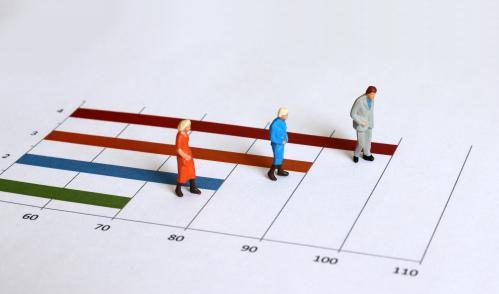Persis Yu is now Policy Director & Managing Counsel at the Student Borrower Protection Center. This was written when she was director of the Student Loan Borrowing Assistance Program at the National Consumer Law Center.
The Hutchins Center on Fiscal & Monetary Policy and the Student Loan Borrower Assistance Project at the National Consumer Law Center organized a series of off-the-record dialogues in 2021 about student loans among people with significantly different views about the nature of the problem and the best prospective solution. The conversations, moderated by the Convergence Center for Policy Resolution, were not intended to reach consensus and didn’t. However, recent focus on Income-Driven Repayment as a way to ease the burdens on student loan borrowers after the COVID-triggered moratorium on student loan repayment expires – including proposals made by President Biden and the Department of Education – led two of the conveners to draft this discussion of some issues in IDR and the pros and cons of some often-mentioned solutions. This essay does not represent the views of Brookings or NCLC nor does it represent the views of participants in the Convergence dialog, although it did benefit from input from some of them.
Unlike with most other loans, the borrower’s ability to repay is not considered when a student loan is made. Income-Driven Repayment was conceived to protect student borrowers from financial hardship – to insure borrowers against the risk that their educations will not pay off in the form of higher wages. (It was also seen by some as a way to assist borrowers who chose low-wage public service careers.) Although details have changed significantly over the years, the basic design is straightforward: Pay a percentage of your monthly income above some threshold for some number of years – possibly zero payments in some months – and you are eligible to get any remaining balance forgiven after some period, usually longer than the standard 10-year period for repaying loans. About one in every three student-loan borrowers whose loan comes directly from the government, known as Direct Loan borrowers, is enrolled in some form of IDR, according to Department of Education data.
Discussion of Income-Driven Repayment dates at least to the 1950s, and Congress created a pilot program in 1992. The report, “Income-Driven Repayment of Student Loans: Problems and Options for Addressing Them,” summarizes the evolution of IDR over the past three decades. It also identifies problems with IDR and the pros and cons of solutions that have been offered for addressing them, including:
- Few borrowers have historically used IDR, including some who would likely have qualified for reduced payments and eventual forgiveness. Many borrowers never learn about IDR and, while federal loan contracts with servicers have improved, IDR is bureaucratically challenging, and servicers have not always had incentives to enroll borrowers in IDR.
- Borrowers who enroll in IDR plans often fail to remain in them, many because they fail to recertify each year, as currently required. U.S. Department of Education data from 2013 and 2014 show that more than half of borrowers in IDR plans did not recertify on time. For some borrowers, this might be intentional (perhaps they find a higher-paying job and/or wish to avoid interest costs by paying their loan faster). But many borrowers fail to recertify because of inattention or because of bureaucratic, technical, or legal difficulties recertifying. For many borrowers, this leads to an increase in required payments (sometimes an increase in the automatic debits from a borrower’s bank account, capitalization of unpaid interest that increases total debt, and delays in payments that extend the life of the loan, and, for some, default).
- Many borrowers find their IDR payment unaffordable. The current formula protects a borrower’s income up to 150% of the federal poverty level and sets monthly payments at up to 10% of the “discretionary income” above that level. The formula for setting IDR monthly payments reflect income and family size, but not regional differences in the cost of living or other expenses a borrower may have. Because individuals file taxes based on prior year’s income, the federal government has no real-time measure of income or employment, so payments are based on last year’s income. If a borrower falls on hard times, for example by losing a job, it falls on the borrower to update their income. Several of the recommendations for the prior problem have also been proposed to address affordability.
- No matter how well-intended IDR is, its success depends on how well it is administered. Borrowers generally deal not directly with the federal government, but with servicers hired by the government to deal with borrowers. Servicing errors and abuses along with Department of Education policies often prevent borrowers from accessing all of the benefits of IDR. For example, lost paperwork can result in delays in IDR processing and a loss of qualifying payments towards cancellation. Many borrowers say that servicers either failed to alert them to the existence of IDR and/or encouraged them to enroll in forbearance and deferment which may not qualify for IDR cancellation. This leads to increased loan balances (interest keeps accruing and is capitalized) and prevents a borrower from accumulating months that could have counted towards the 25-year forgiveness threshold. In part, this reflects Department of Education guidance to servicers; the GAO found the Department’s “instructions and guidance to loan servicers are sometimes lacking, resulting in inconsistent and inefficient services to borrowers.”
- Many borrowers in IDR do not make payments large enough to cover the accruing interest, so they see their balances grow over time. Even though their balances may eventually be forgiven, rising balances are, to say the least, discouraging to borrowers who are making required monthly payments and can mar borrowers’ credit reports. In contrast, borrowers in fixed-payment plans see their balances fall over time. In certain repayment plans the government subsidizes the interest to reduce or eliminate this problem. For instance, for qualifying loans under REPAYE, the government pays 100% of the interest for the first 36 payments in which a borrower’s payments don’t cover the interest, and then the government subsidizes 50% of the interest on any subsequent payments.
The Brookings Institution is financed through the support of a diverse array of foundations, corporations, governments, individuals, as well as an endowment. A list of donors can be found in our annual reports published online here. The findings, interpretations, and conclusions in this report are solely those of its author(s) and are not influenced by any donation.







